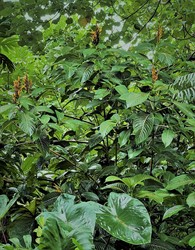Sanchezia; it is also known as shrubby white vein.
Pacific Pests, Pathogens, Weeds & Pesticides - Online edition
Pacific Pests, Pathogens, Weeds & Pesticides
Sanchezia (538)
Sanchezia parvibracteata. It is a member of the Acanthaceae family.
Asia, North (including Hawaii and Puerto Rico), South and Central America, Oceania. It is recorded from Australia, Cook Islands, Federated States of Micronesia, New Caledonia, Niue, Palau, and Tonga. It is native to tropical South America.
Sanchezia is invasive in moist to wet native and secondary forests of the tropics and subtropics, from lowlands to mountainous areas, up to 800-1000 masl (Photo 1). Dense stands occur in forests and forest edges, along streams and rivers, and in other damp areas.
It is an erect shrub to 2 m. The stems are 4-angled. Leaves opposite, oval, 25 cm long and 7 cm wide, glossy green, with white midribs, a reddish basal section, and white to yellow secondary veins (Photo 2). The flowers are in dense clusters, up to 15 cm long, at the ends of stalks; each flower has bright red, leaf-like sepals at the base, 15 mm long, surrounding a 4-5 cm long tube-like yellow to orange corolla (fused petals), from which two of four stamens (male parts) protrude (Photo 3).
Spread of Sanchezia is by vegetative growth over short distances, not by seeds as it rarely produces them. Stem pieces readily take root and can be spread in garden waste or in moving water. Long distance spread occurs with commercialisation of sanchezia as an ornamental or hedge plant. It is available for sale on the Internet.
Sanchezia forms dense thickets in the understory of mature and secondary forests, especially in lowland areas. It outcompetes native species, making it a threat to biodiversity in Australia, New Caledonia, Hawaii and Costa Rica, in particular.
Used extensively as an ornamental for gardens and as a house plant.
BIOSECURITY
The chances of introduction of sanchezia are high as it is commonly used as an ornamental and house plant in the subtropics and tropics. Countries not yet infested should consider all likely pathways for entry and apply quarantine measures accordingly. Particular attention should be given to the fact that invasions are usually associated with nearby gardens, and its ready availability on the Internet.
BIOLOGICAL CONTROL
Not a method recommended for Sanchezia parvibracteata.
CULTURAL CONTROL
Physical & Mechanical:
- Hand-pulling is possible for isolated plants or small plantings.
- ensure all stem fragments and roots are removed; collect and burn them, otherwise they may resprout if left on or in the soil.
- Do not use topsoil from places where sanchezia has been growing. Movement of soil from such places is a major method of spread of this weed.
CHEMICAL CONTROL
In Queensland, Australia, people generally are allowed to use the following for the control of sanchezia as an environmental weed under a permit issued to the Department of Agriculture & Fisheries: fluroxypyr; triclopyr + picloram; triclopyr + picloram + aminopyralid. The permit is for non-agricultural areas, domestic and commercial spaces, bushland, native forests, roadsides, wastelands, wetlands, and coastal areas.
____________________
When using a pesticide, always wear protective clothing and follow the instructions on the product label, such as dosage, timing of application, and pre-harvest interval. Recommendations will vary with the crop and system of cultivation. Expert advice on the most appropriate herbicides to use should always be sought from local agricultural authorities.
AUTHOR Grahame Jackson & Konrad Englberger
Information from Sanchezia (2020) Business Queensland, Queensland Government. (https://www.business.qld.gov.au/industries/farms-fishing-forestry/agriculture/biosecurity/plants/invasive/other/sanchezia); and CABI (2014) Sanchezia parvibracteata (sanchezia). Crop Protection Compendium. (https://www.cabidigitallibrary.org/doi/10.1079/cabicompendium.120290); and from Sanchezia Sanchezia parvibracteata (2020) The State of Queensland, Department of Agriculture and Fisheries. (https://www.daf.qld.gov.au/__data/assets/pdf_file/0020/61805/sanchezia.pdf). Photo 1 Konrad Englberger, Pohnpei, Federated States of Micronesia. Photos 2&3 Gerald McCormack, Cook Islands Biodiversity Database, Version 2007.2. Cook Islands Natural Heritage Trust, Rarotonga. (http://cookislands.bishopmuseum.org/).
Produced with support from the Australian Centre for International Agricultural Research under project HORT/2016/185: Responding to emerging pest and disease threats to horticulture in the Pacific islands, implemented by the University of Queensland and the Secretariat of the Pacific Community.






